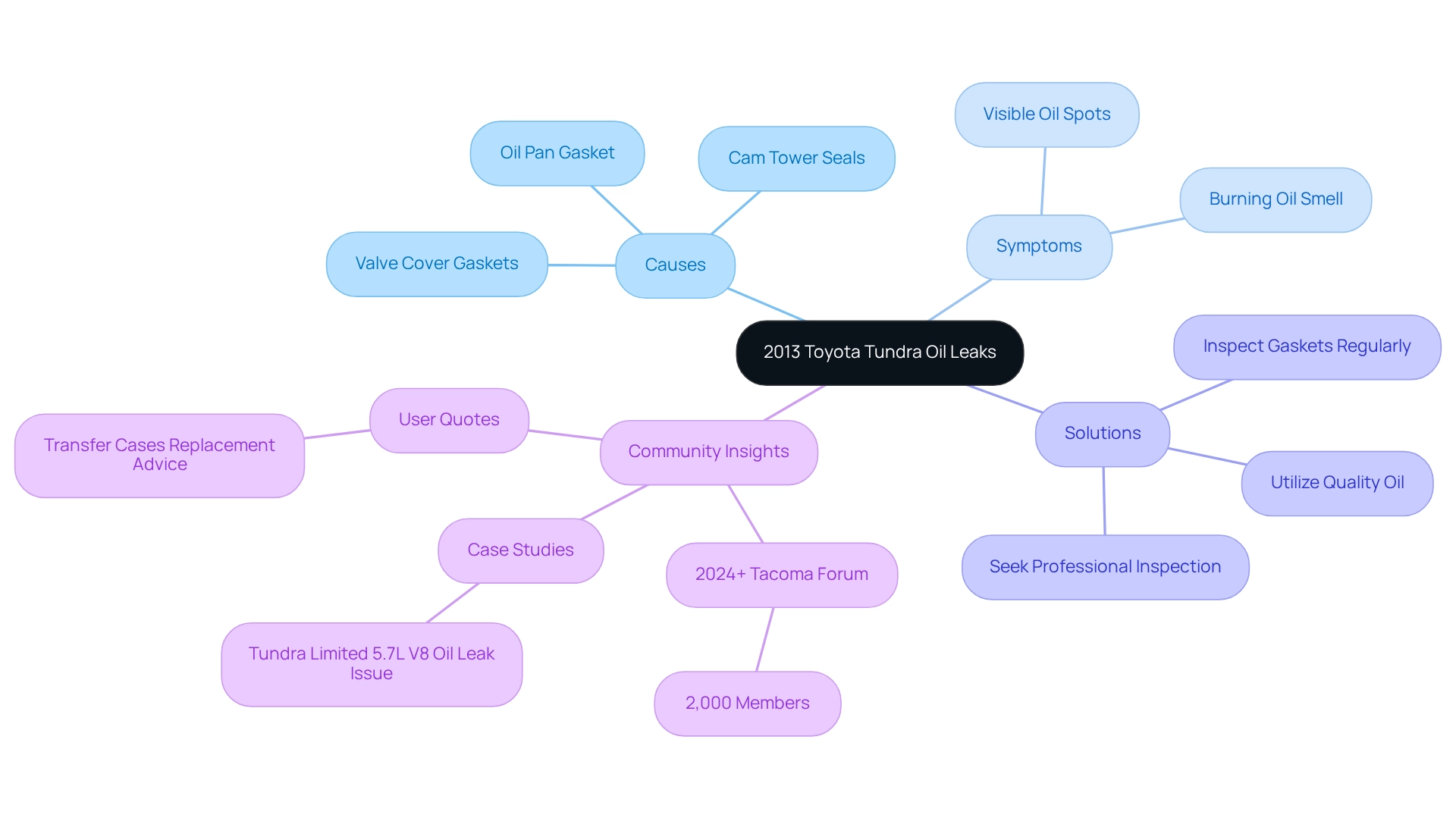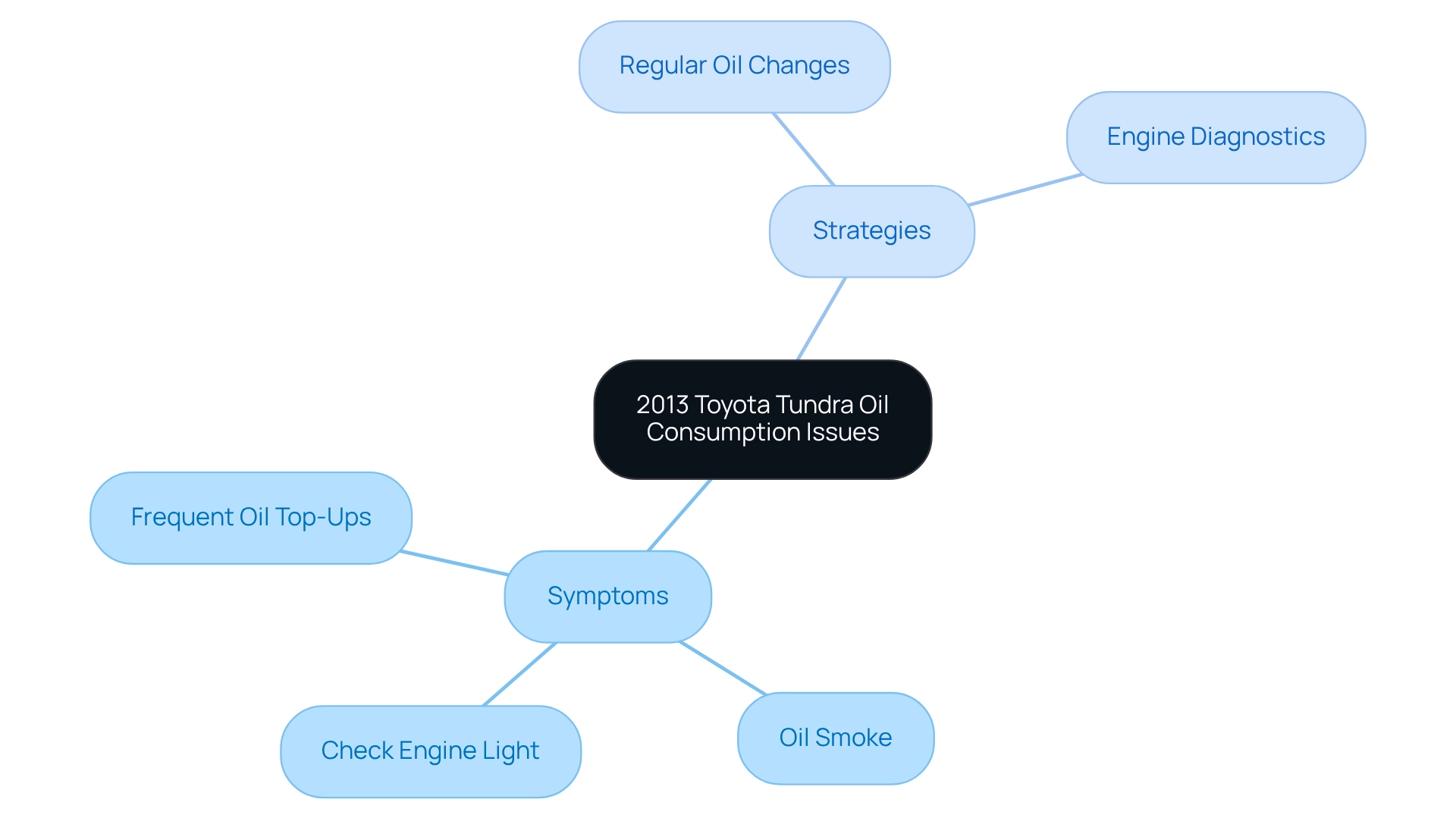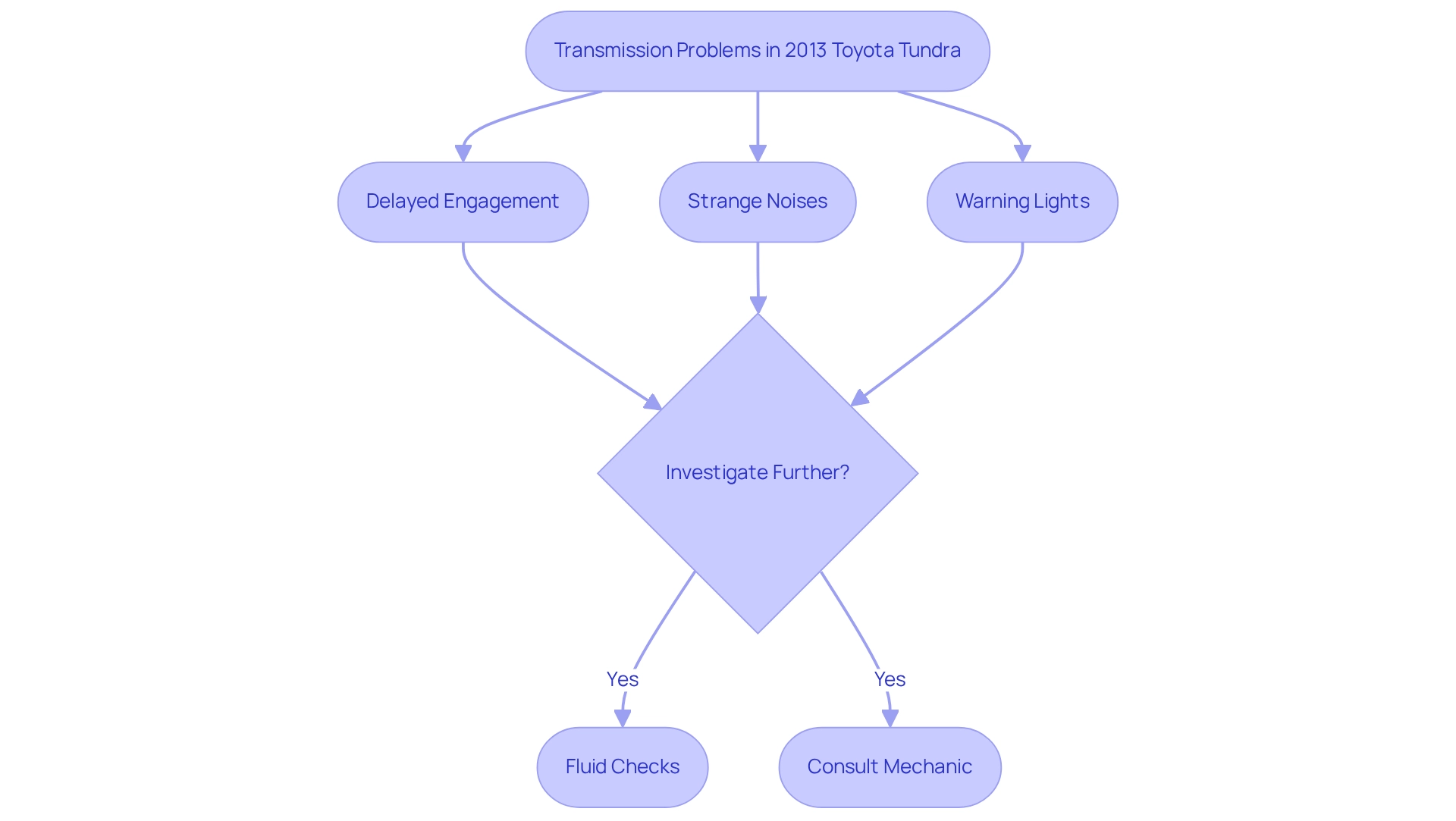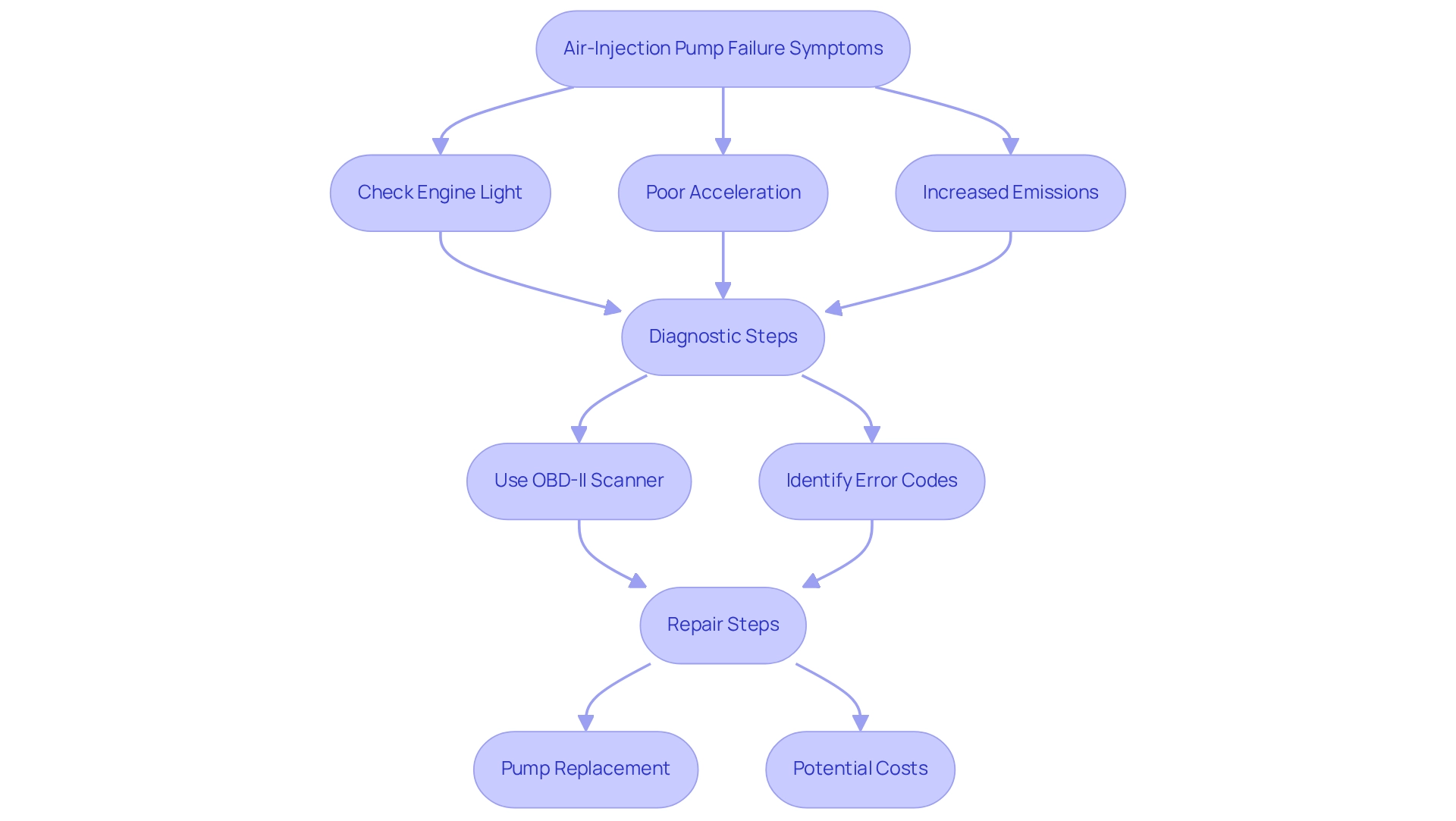7 Common 2013 Toyota Tundra Problems and Solutions

Overview
This article addresses common problems faced by the 2013 Toyota Tundra, such as:
- Oil leaks
- Excessive oil consumption
- Transmission issues
- Rust problems
- Air-injection pump failures
Each issue is accompanied by specific symptoms, preventive measures, and repair recommendations. Regular maintenance and prompt action are emphasized to mitigate these issues and maintain vehicle performance.
Understanding these problems is crucial for Tundra owners. Oil leaks can lead to engine damage, while excessive oil consumption may indicate deeper mechanical issues. Transmission problems can affect drivability, and rust can compromise the vehicle’s integrity. Air-injection pump failures can impact emissions and overall efficiency.
To address these challenges effectively, it is vital to recognize the symptoms early. For instance, if you notice oil spots where you park, it may indicate a leak. Regular inspections can help catch these issues before they escalate.
Preventive measures include scheduled maintenance checks and using high-quality fluids. These practices not only enhance the vehicle’s longevity but also improve performance. Repair recommendations vary depending on the issue, but acting quickly can save time and money in the long run.
In conclusion, staying informed about these common problems and implementing regular maintenance can significantly enhance the performance and reliability of your 2013 Toyota Tundra.
Introduction
In the realm of truck ownership, the 2013 Toyota Tundra stands out for its robust performance and reliability. This truck offers impressive towing capacity, a spacious interior, and a strong V8 engine, making it a popular choice among enthusiasts. However, like any vehicle, it is not without its challenges. From oil leaks and excessive consumption to transmission troubles and rust issues, Tundra owners must navigate a variety of potential pitfalls to keep their trucks in top condition.
What are the common problems faced by 2013 Toyota Tundra owners? This article delves into these issues, offering insights into their causes, symptoms, and effective solutions. By understanding these challenges and implementing proactive maintenance strategies, owners can ensure the longevity and performance of their beloved trucks.
2013 Toyota Tundra Oil Leaks: Causes and Solutions
The 2013 Toyota Tundra problems include oil leaks that can originate from various components, notably the valve cover gaskets, oil pan gasket, and cam tower seals. Symptoms often include visible oil spots beneath the vehicle and a burning oil smell, indicating potential issues that require attention. To effectively manage these leaks, owners should consider the following strategies:
- Inspect Gaskets Regularly: Conduct routine checks on the condition of gaskets and seals. Indicators of wear should trigger prompt replacement to avoid additional leakage.
- Utilize Quality Oil: Choosing premium oil that meets manufacturer specifications can greatly reduce the likelihood of leaks, ensuring optimal engine performance.
- Seek Professional Inspection: If oil leaks continue despite preventive actions, it is recommended to consult a qualified mechanic for a thorough inspection. This may involve gasket substitutions or other essential repairs.
In a significant instance, a Limited model with a 5.7L V8 engine encountered a cam tower seal leak at only 30,350 miles. This issue was identified during a routine inspection, emphasizing the importance of proactive maintenance. The dealer provided a loaner vehicle at no cost while repairs were conducted, showcasing the benefits of addressing such issues early.
Expert opinions suggest that while transfer cases are less costly to replace, it is prudent for buyers to ensure that any potential oil leak issues are disclosed during the sale process, as this can impact overall maintenance costs. Participating in community forums, like the 2024+ Tacoma Forum with its 2,000 participants, can offer further insights and assistance for those dealing with similar challenges. Readers are encouraged to engage in these forums and share useful resources regarding the 2013 Toyota Tundra problems, fostering a community of support and information exchange.

2013 Toyota Tundra Excessive Oil Consumption: What to Watch For
High oil usage is one of the common 2013 Toyota Tundra problems for drivers, often linked to worn piston rings or valve seals. Key symptoms to monitor include:
- Frequent Oil Top-Ups: Are you adding oil more often than usual? This could indicate a problem.
- Oil Smoke: Blue smoke from the exhaust is a clear sign of burning oil, suggesting excessive consumption.
- Check Engine Light: An illuminated check engine light may also indicate oil-related issues.
To address excessive oil consumption, consider the following strategies:
- Regular Oil Changes: Sticking to a consistent oil change schedule with the recommended oil type can help maintain engine health.
- Engine Diagnostics: If you notice high oil consumption, it’s wise to have a mechanic conduct a diagnostic to check for internal engine wear. As noted by Choisser Automotive Services, “At Choisser Import Auto Services we’ll be happy to take a look at your Toyota and let you know your options.”
Statistics suggest that if an engine uses 1 quart of oil or more during testing, the owner qualifies for a free repair, highlighting the importance of monitoring oil levels. Real-life experiences shared by vehicle owners indicate that 2013 Toyota Tundra problems, such as substantial oil usage—like 3 quarts—can lead to more serious engine issues, potentially requiring a rebuild. One individual, known as ‘panicman,’ stressed that such consumption is a significant concern that should not be ignored. By remaining vigilant and proactive, vehicle owners can mitigate these issues and ensure their automobile remains in peak condition. Additionally, considering the reputation of oil brands is essential, as consumer trust significantly influences oil selection and impacts overall engine performance.

2013 Toyota Tundra Transmission Problems: Signs and Remedies
The 2013 Toyota Tundra problems may include transmission issues that manifest as delayed shifting, slipping gears, or unusual noises. Key indicators of these issues include:
- Delayed Engagement: A noticeable lag when shifting from park to drive.
- Strange Noises: Grinding or whining sounds during operation.
- Warning Lights: Activation of transmission warning lights on the dashboard.
Statistics suggest that a substantial proportion of vehicle proprietors report encountering delayed shifting, a common issue among 2013 Toyota Tundra problems. This can lead to additional issues if not resolved quickly. To address these concerns effectively, consider the following:
- Fluid Checks: Regularly inspect and replace transmission fluid to maintain optimal performance.
- Professional Service: If issues persist, consult a qualified mechanic for a thorough diagnosis and repair of transmission problems. As mentioned by Stevinson Motors West, “Call the service consultants at Stevinson Motors West and let us assist you.”
Understanding these indicators and solutions is crucial, especially considering that the 2013 Toyota Tundra problems may arise from its primary off-road function, which can contribute to maintenance challenges. By recognizing these issues early, owners can reduce the risk of potential transmission failures, ensuring their automobile operates smoothly.

2013 Toyota Tundra Rust Problems: Prevention and Treatment
Rust issues are among the common 2013 Toyota Tundra problems, especially in areas frequently exposed to humidity and road salt. Thus, preventive maintenance is essential. To effectively prevent and treat rust, consider the following strategies:
- Regular Inspections: Conduct thorough checks of the undercarriage and wheel wells for early signs of rust. This vigilance helps catch problems before they escalate, ensuring your vehicle remains in optimal condition.
- Rustproofing: Applying a rustproofing treatment to vulnerable areas significantly enhances protection against corrosion. Experts recommend starting this process early in the vehicle’s lifespan to maximize effectiveness. For example, Mike Sander’s grease should be sprayed at 120 C for optimal results.
- Repair Rust Spots: Address any rust spots immediately using rust-inhibiting paint or by seeking professional services. Timely repairs can prevent further corrosion and extend the lifespan of your vehicle’s undercarriage.
In recent discussions, participants debated the merits of oil versus wax treatments for rust prevention. This highlights the importance of choosing the right method based on effectiveness and cost. Have you considered which treatment suits your vehicle best? Additionally, a user shared their long-term maintenance strategy, emphasizing that consistent application of undercoating products can greatly reduce the risk of rust and corrosion over time. They noted that aside from Nox Rust 712 AM (which was utilized by a vehicle manufacturer), they have not found evidence of efficacy in other additives such as Krown or Rust Check. By following these expert suggestions and practical examples, vehicle owners can effectively protect their automobiles from rust and ensure durability.

2013 Toyota Tundra Air-Injection Pump Failure: Diagnosis and Fixes
The air-injection pump in the 2013 Toyota Tundra is known for its susceptibility to failure, which can present through several key symptoms:
- Check Engine Light: This is a common indicator of pump malfunction, often triggered by related error codes.
- Poor Acceleration: Drivers may notice a significant decline in engine performance, impacting the overall driving experience.
- Increased Emissions: A failing pump can result in elevated emissions, raising environmental concerns and risking failure in emissions tests.
To effectively tackle these issues, consider the following diagnostic and repair steps:
- Diagnostic Codes: Utilizing an OBD-II scanner can help identify any error codes linked to the air-injection system, providing insights into the specific nature of the problem.
- Replacement: If diagnostics confirm pump failure, a replacement is typically necessary to restore the vehicle’s performance and ensure compliance with emissions standards.
Real-world experiences underscore the financial burden associated with air-injection pump repairs, with costs often surpassing $2,000. A case study titled ‘Financial Burden of Air Injection Pump Repairs’ reveals that many users experienced significant dissatisfaction due to the 2013 Toyota Tundra problems related to these high costs. This highlights the importance of understanding warranty coverage for potential reimbursement options. Many individuals have expressed relief at having warranty options available, which can mitigate long-term expenses. As Paul, a representative of Hewitt Tech, noted, “The GenII installation is even simpler than our current V36 and V54 units with no need for the starter relay sense wire that connects to the starter relay and we don’t have to mess with things at startup.”
By proactively diagnosing and addressing air-injection pump issues, owners can maintain their vehicle’s reliability and avoid the financial strain associated with repairs.

Conclusion
The 2013 Toyota Tundra, while a robust and reliable truck, presents several challenges that owners must be prepared to face. Common concerns include:
- Oil leaks
- Excessive consumption
- Transmission issues
- Rust problems
Understanding these issues is crucial for maintaining the vehicle’s performance and longevity. Proactive measures such as regular inspections, timely repairs, and quality maintenance can effectively mitigate many of these challenges.
Addressing oil leaks and consumption requires vigilance in monitoring symptoms like frequent oil top-ups and visible leaks. Likewise, transmission problems necessitate routine fluid checks and professional assessments to ensure smooth operation. Rust prevention is equally important; regular inspections and rustproofing treatments can significantly extend the life of the vehicle’s body. Lastly, being aware of potential air-injection pump failures allows owners to take early action, preventing costly repairs down the line.
By staying informed and engaged with the Tundra community, owners can share experiences and solutions that foster a supportive environment. This collective knowledge empowers Tundra owners to tackle these issues head-on and reinforces the importance of proactive maintenance. Ultimately, a well-maintained Tundra can continue to deliver the performance and reliability that has made it a favorite among truck enthusiasts.
Frequently Asked Questions
What are common problems with the 2013 Toyota Tundra?
Common problems include oil leaks from components like valve cover gaskets, oil pan gasket, and cam tower seals, as well as high oil consumption linked to worn piston rings or valve seals.
What symptoms indicate oil leaks in the 2013 Toyota Tundra?
Symptoms of oil leaks include visible oil spots beneath the vehicle and a burning oil smell.
How can owners manage oil leaks in their 2013 Toyota Tundra?
Owners can manage oil leaks by regularly inspecting gaskets, using quality oil that meets manufacturer specifications, and seeking professional inspection if leaks persist.
Can you provide an example of a specific oil leak issue in the 2013 Toyota Tundra?
A Limited model with a 5.7L V8 engine experienced a cam tower seal leak at only 30,350 miles, which was identified during a routine inspection.
What should buyers consider regarding oil leaks when purchasing a used 2013 Toyota Tundra?
Buyers should ensure that any potential oil leak issues are disclosed during the sale process, as this can impact overall maintenance costs.
What are the signs of high oil consumption in the 2013 Toyota Tundra?
Signs of high oil consumption include frequent oil top-ups, blue smoke from the exhaust, and an illuminated check engine light.
What strategies can help address excessive oil consumption in the 2013 Toyota Tundra?
Strategies include regular oil changes with the recommended oil type and having a mechanic conduct diagnostics to check for internal engine wear.
What should owners do if their engine uses a quart of oil or more during testing?
If an engine uses 1 quart of oil or more, the owner qualifies for a free repair, highlighting the importance of monitoring oil levels.
Why is it important to consider the reputation of oil brands for the 2013 Toyota Tundra?
The reputation of oil brands is important because consumer trust influences oil selection and can impact overall engine performance.





